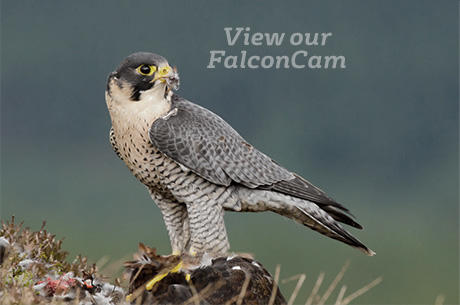Peregrine Falcons
By the 1960s, the peregrine falcon had become an endangered species due to the widespread use of DDT(which was later banned in the 1970s). Efforts to repopulate the peregrine falcon species have included the introduction of birds raised in captivity to urban landscapes where tall buildings, close proximity to water and sources of pigeons and starlings for food approximate the bird’s preferred natural habitat.
In 1999, an adult pair of peregrines nested under the Hoan Bridge at the intersection of several massive steel girders. Generally, bridges are unsafe nesting sites for peregrines because the young often end up in the water below and drown when they fledge and take their first flights, but this particular instance was successful in producing four young.
Recognizing the opportunity to assist this endangered species, Veolia employees gave the peregrines a helping hand by installing a nest box on the roof of the Milorganite® Building in 2008. The falcons took to their new home and have been nesting there ever since.
As part of our efforts to not only provide these falcons with adequate nesting places, we’ve also set up live cameras to monitor the nests and provide the public access to observe these birds online and learn more about them.
About Peregrine Falcons
Prey
Peregrines take their prey in flight, so they dine almost exclusively on other birds. However, very young falcons may catch flying insects and, occasionally, Arctic peregrines will catch and eat ground-dwelling animals like lemmings. Male peregrines, which are substantially smaller, will generally catch smaller birds, but females will take larger prey like ducks. Peregrines can eat as much as one-quarter of their weight at one sitting.
Reproduction
Peregrines usually begin breeding at about two years of age. The female chooses her mate based on the male's aerial courtship display. Peregrines generally mate for life, returning each year to the same area and even the same nest. However, the female will accept a new mate if the first is killed.
Nesting Timeline at Jones Island
- April: Females lay a clutch of 3 to 5 eggs
- May: It takes about a month for the eggs hatch
- June/July: Peregrines first fly 35 to 45 days after hatching
- September/October: Peregrines begin to hunt around 60 to 80 days after hatching
Newly hatched peregrines, weighing in at about 1.5 ounces, double their weight in just six days and increase to ten times that within three weeks. The mortality rate is very high for young peregrines. Only one in 10 makes it to breeding age. They can live for up to 15 years.
Range / Migration
Peregrines are found all over the world except in Antarctica and the Pacific Islands. The most common subspecies in the United States, falco peregrinus anatum, is found from central Alaska to central Mexico and usually winters in South America. A maritime subspecies, Peale’s peregrine, found in the Northwestern U.S. and north, does not migrate. Some urban peregrines, such as the ones found on top of the Milorganite® Facility, do not migrate anymore, since their prey—pigeons and starlings—remain abundant year round.



